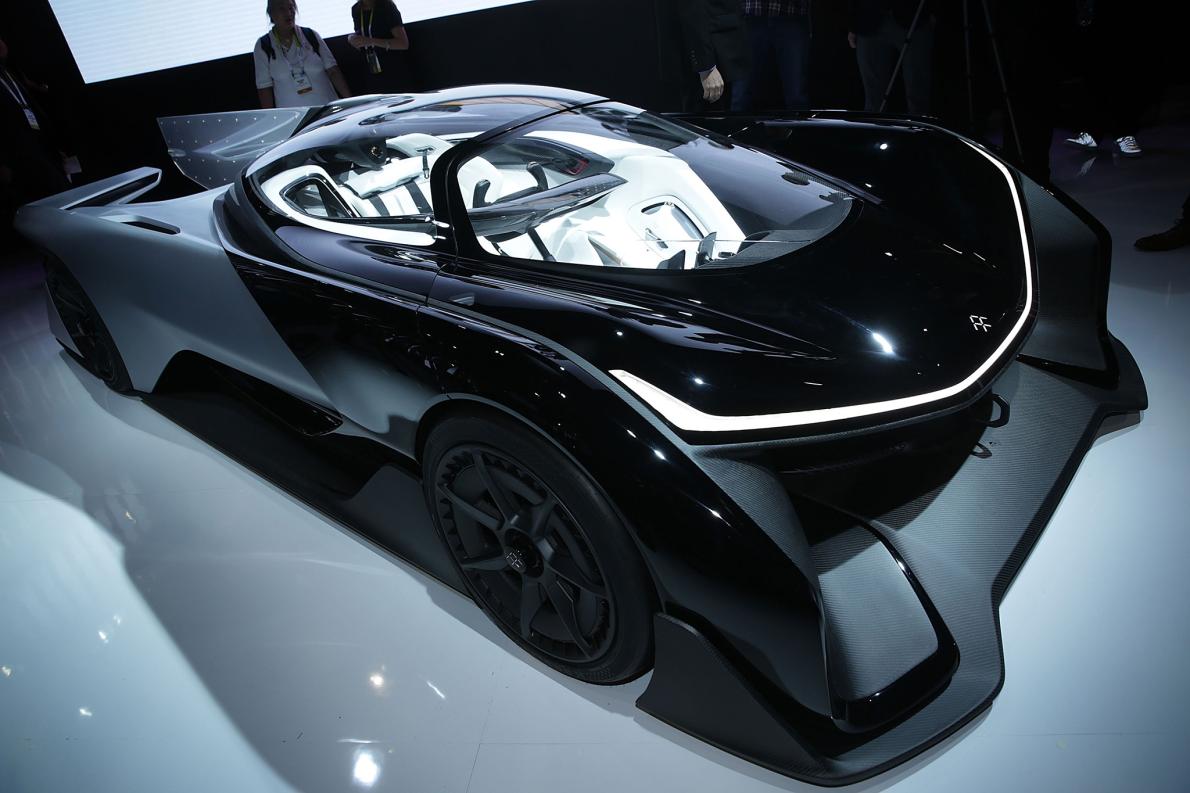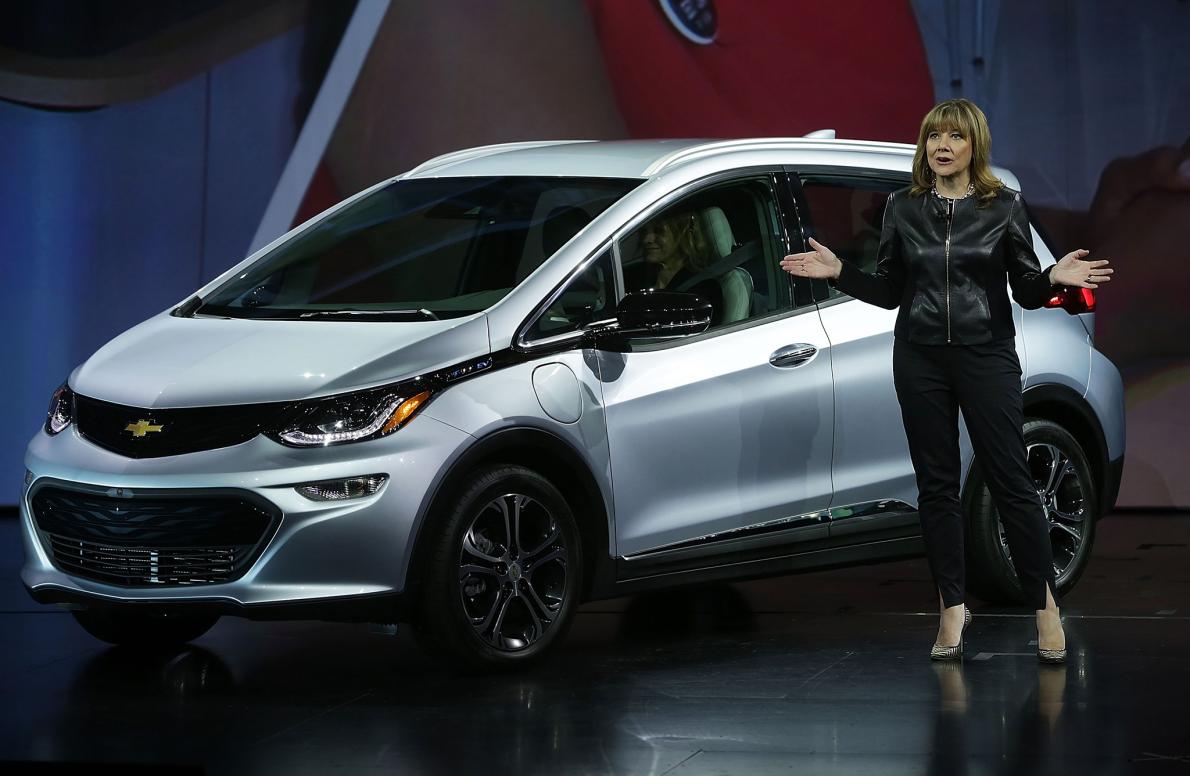Automakers are showcasing new battery-powered and hydrogen smart vehicles, including a car that will sell for about $30,000 and a futuristic one that’s so sleek it could be the envy of Batman.
These cars promise to go farther on a single charge, drive themselves (at least partly), or operate the lights, appliances, and garage doors of our homes. Some are just concepts that may never get built, but others like General Motors’ all-electric Chevy Bolt will go on sale next year.
We see the vehicle of the future as more than just a mode of transportation.
They debuted this week in Las Vegas at CES, a consumer electronics trade show that’s gaining cachet in the auto world as cars increasingly become computers on wheels. At least nine automakers and 115 auto-tech companies showed their products, taking up 25 percent more square footage than last year—even though a major auto show takes place next week in Detroit.
“Automakers are seeing that technology is playing a bigger part in the car,” said Laura Hubbard, spokeswoman of the Consumer Technology Association, which organizes the annual show. “They don’t talk about themselves as auto companies,” she said in an interview of the shift. “They see themselves as mobility companies.”

So the companies didn’t unveil just cars, they announced partnerships and plans. General Motors will invest $500 million in Lyft, the ride-hailing service, to create a network of on-demand autonomous vehicles. Toyota named the team for its $1 billion research effort, in connection with Stanford and MIT, to develop artificial intelligence and robotics. Ford described how it’s using Amazon products to marry smart cars with smart homes so drivers can operate wifi-connected home devices.
“We see the future of mobility as connected, seamless and autonomous,” GM President Dan Ammann said in announcing the partnership with Lyft, similar to Ford’s deal last year with car-sharing startup Getaround.
Toyota’s Bob Carter said the vehicle of the future is “more than just a mode of transportation,” noting its ability to be more useful and “exciting.” He said the next generation of “connected and automated” cars will arrive “sooner than you think.”
Glimpses of what they may look like were on display at CES, including BMW’s i8 Mirrorless concept car that replaces side mirrors with cameras facing backwards and Mercedes Benz’ aerodynamic Concept IAA with glowing dashboard.
Toyota, which began selling its hydrogen-powered Mirai last year in the United States and Europe, showed off a few hydrogen concept cars, such as the two-seater FCV Plus.
The biggest head-turner was the single-seat FFZERO1, a super fast electric car that looks like the winged Batmobile. Its maker, California-based Faraday Future, calls it a “car of concepts” and “engineering marvel” but not a production-ready EV. The well-funded but somewhat mysterious company, which plans to break ground soon on a $1 billion factory outside of Las Vegas, has led to rumors that it could be Apple’s covert move into the auto industry.

GM’s Bolt
Much more practical is the 2017 Chevy Bolt—not to be confused with its 2016 Volt. The new model is a four-door electric car that seats five people, rides 200 miles on a fully-charged battery, and reaches an 80 percent charge in an hour. GM chairman Mary Barra said it will go into production this year and be available next year for about $30,000, after government rebates.
“It’s the first EV that cracks the code of long range and affordable prices,” she said at CES. “We see the Bolt as more than a car. It’s an upgradable platform for new technology.” She took a swipe at auto newcomers like Elon Musk’s Tesla, saying Bolt customers “don’t have to drive to another state to buy or service an EV” because GM has 3,000 dealerships.
Volkswagen’s BUDD-e
The German automaker, now facing a multi-billion-dollar lawsuit from the U.S. government because of its emissions scandal, unveiled an electric microbus called BUDD-e. It said the “avant-garde van,” about the length of the Toyota Prius-v wagon, has a driving range of up to 373 miles and can be operated with touches or gestures.
Volkswagen said BUDD-e passengers will be able to access their offices and smart homes so they can perform tasks such as adjusting the air conditioning, turning lights on or off and checking to see if the kids are home. It expects to have production cars, using its modular electric platform, available by 2019.
Audi, its luxury brand, announced this week that it aims to increase its share of electric cars to a quarter of U.S. sales by 2026. It plans to begin production of its e-Tron, an all-electric sport utility vehicle, by 2018.
Ford’s talking cars
The company founded by Henry Ford said it’s working to pair technologies. It wants to make its SYNC Connect technology—now in 15 million of its cars—work with two Amazon products: Echo, a hands-free speaker and voice command device, and Alexa, a cloud-based voice service. By pairing these, Ford owners could access their vehicles from inside their home—or vice versa.
For example, an owner could say: “Alexa, ask my car for its driving range,” and Alexa could reply: “You have an available range of 56 miles.”
Inside the car, a driver would access Alexa via the steering wheel-mounted voice recognition button and make requests of connected devices. He or she could ask and receive answers to questions such as “Is my garage door open?” or “Turn on my porch lights.”
Ford said it’s also working with Wink, a smart home platform that allows devices from different—but not all—companies to work together.
Lingering Obstacles
That’s one of the challenges facing smart cars. Currently, not all wifi-connected devices talk to each other, because they have different operating platforms. Apple has its HomeKit devices, Google has Nest products, Amazon has Echo, and Samsung has SmartThings.
Another obstacle for electric or hydrogen-fueled vehicles, which tend to cost more than traditional cars, is the low price of gasoline. With gas costing about $2 a gallon in many parts of the U.S., sales rose last year for pickup trucks and SUVs but fell for the all-electric Nissan Leaf and the popular hybrid Toyota Prius.
Plus, self-driving cars will need both public acceptance and government approval. Gradually, states and countries are starting to give the thumbs up. Last year, the United Kingdom allowed driverless vehicles on public roads, and last month, California unveiled preliminary rules for them, requiring consumers to get a special state-issued driver’s certificate.
Automakers say they’re making progress. “A decade ago, no one in the field knew what the art of the possible was,” Jim McBride, Ford’s technical leader for autonomous vehicles, said in an announcement that Ford will triple its fleet of Fusion Hybrid self-driving research cars this year on the roads of California, Arizona, and Michigan.
McBride added: “Today, we’re hustling to make the most ambitious dreams become a reality.”
The story is part of a special series that explores energy issues. For more, visit The Great Energy Challenge.








You must be logged in to post a comment.